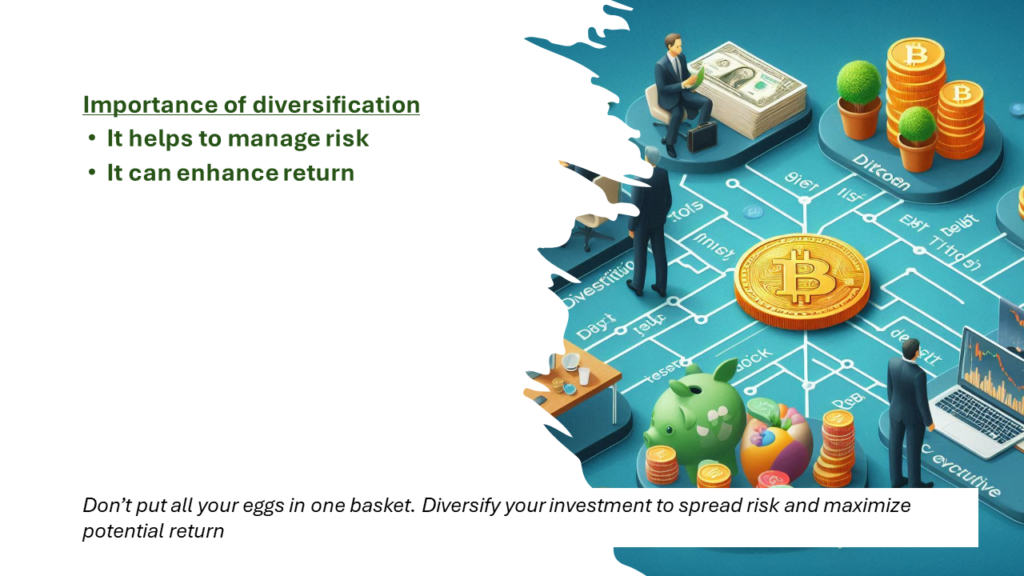Introduction
Investing is super important if you want to build wealth over time. But, let’s be honest, a lot of people find it tricky to invest their money wisely. One smart strategy that experts often talk about is something called diversification. Now, this might sound complicated, but it’s actually pretty simple and can really help reduce risk while boosting your chances of making money.
In this essay, we’ll break down the following discussion points:
- What diversification means
- Why it’s so important
- Types of Diversification
- How to Implement Diversification
- Examples of Succesful Diversification
- Common Mistakes to Avoid
What is Diversification?
Diversification means spreading out your money across different types of investments. So you’re not putting all your eggs in one basket. Instead of investing everything in just one thing, like a single stock, you spread it out among various options. This way, if one investment doesn’t do well, others might perform better, balancing things out for you.
For instance, let’s say you put all your savings into just one company’s stock. If that company runs into trouble, you could lose a lot of money. But, if you diversify by also investing in other stocks, bonds, real estate, and even things like gold, then if one investment doesn’t do so great, the others can help make up for it. This helps keep your overall investment safer and more balanced.

What is the Importance of Diversification?
Diversification is super important for a couple of reasons. First, it helps you manage risk. When you spread your money across different types of investments, you’re less likely to get hurt if one of them doesn’t do well. For example, if the stock market takes a dive, your bonds or real estate might still hold steady. They could even go up in value.
Second, diversification can actually boost your returns. Different investments do well under different conditions. Stocks might skyrocket when the economy is doing great. On the other hand, bonds might stay solid during tougher times. By diversifying, you’re more likely to have something in your portfolio that’s doing well, no matter what’s happening in the economy.
Types of Diversification
Let’s talk about three ways you can diversify your investments to keep things balanced and reduce risk.
Asset Class Diversification.
This means putting your money into different types of things, like stocks, bonds, real estate, and even stuff like gold. Each of these reacts differently to what’s happening in the market. For example, stocks can give you big returns, but they can be risky. On the other hand, bonds are usually safer but don’t earn as much. By mixing these up, you’re not putting all your money in one place.
Sector Diversification.
Even within a single type of investment, like stocks, you can spread your money across different parts of the economy. For instance, you could invest in technology, healthcare, finance, and consumer goods companies. Each of these sectors does well or struggles depending on what’s going on in the world. So, if one sector isn’t doing great, another one might be doing awesome, which helps balance things out.
Geographic Diversification
This is about spreading your investments across different countries. You might invest in companies based in the U.S., Europe, and Asia. Since each region has its own economy, a problem in one country might not affect the others as much. This helps keep your investments more stable no matter what’s happening around the world.
How to Implement Diversification
Let’s break down how you can diversify your investments in a way that makes sense for you.
Assess Your Risk Tolerance
This just means figuring out how much risk you’re comfortable taking. Some people are okay with a little more risk if it means the chance for bigger rewards, while others prefer to play it safe. Your comfort level will help you decide where to put your money. If you’re not a fan of taking risks, you might want to put more money into safer things like bonds and less into riskier things like stocks.
Choose Your Investments
Once you know your risk tolerance, you can pick a mix of assets that works for you. For example, you might decide to put 60% of your money in stocks, 20% in bonds, 10% in real estate, and 10% in commodities like gold. It’s also smart to spread your investments across different sectors and regions to keep things balanced.
Regularly Review and Rebalance
Diversifying your investments isn’t something you do just once and forget about. As things change—whether it’s the market or your own financial situation—you’ll need to check in on your investments and make adjustments. This way, your portfolio stays in line with your goals and risk tolerance.
Mutual Funds or ETFs
If picking individual investments feels a bit overwhelming, you might want to look into mutual funds or exchange-traded funds (ETFs). These are like baskets of different investments that you can buy into. They give you instant diversification. Plus, professionals manage them. This means you don’t have to worry about doing all the work yourself.
Examples of Successful Diversification
Let’s take a look at a few real-life examples to see how diversification can help protect your investments.
The 2008 Financial Crisis: Back in 2008, the stock market took a huge hit, and many investors lost a lot of money. But, those who had spread out their investments, like having some money in bonds and real estate, didn’t lose as much. Bonds and real estate actually did better during that tough time, helping to balance out the losses from the stock market.
The Tech Boom and Bust: In the late 1990s, technology stocks were on fire. Lots of people made big gains. But when the tech bubble burst in 2000, many of those stocks dropped in value quickly. Investors who had diversified by also putting money into stocks from other sectors didn’t get hit as hard. Those with different types of investments were better protected from these losses
The Rise of Emerging Markets: Recently, investing in countries with fast-growing economies, like China and India, has become really popular. These markets offered the chance for big growth. However, they also came with more risk. Investors who spread their money between these emerging markets and more stable, developed markets were able to enjoy the growth. At the same time, they kept their overall risk in check.
Common Mistakes to Avoid
Let’s talk about a few things to watch out for when you’re diversifying your investments.
Over-Diversification
While it’s great to spread out your investments, doing it too much can actually work against you. If you spread your money across too many different investments, you might not see big gains from any of them. So, it’s important to find the right balance that matches your financial goals.
Quality
Just because you’re diversifying doesn’t mean you should invest in anything and everything. Make sure the investments you pick are solid and have the potential to grow. Investing in low-quality assets just to diversify can end up hurting you in the long run.
Rebalance
We’ve talked about this before, but it’s super important. If you don’t check in and make adjustments now and then, your portfolio could get out of whack. This could mean you’re taking on more risk than you’re comfortable with. It could also mean you’re missing out on potential gains. So, keep an eye on things and rebalance as needed.
Conclusion
Diversification is a super important strategy for building and keeping your wealth. By spreading your money across different types of investments, sectors, and even regions, you can help manage risk. This also boosts your chances of earning returns. It’s a good idea to figure out how much risk you’re comfortable with. Then, pick a mix of investments that match your goals. Make sure to regularly check in on your portfolio.
Just remember, while diversification is a powerful tool, it doesn’t guarantee success on its own. But it’s definitely one of the best ways to reduce risk. It helps you work towards your long-term financial goals. By using these strategies and avoiding common mistakes, you can build a stronger, more reliable investment portfolio. This will move you closer to financial security.
Investing wisely does take some time and effort. However, the benefits of diversification can really make a big difference in your financial journey.
Disclaimer:
The information provided in this document is for educational purposes only and does not constitute financial advice.

